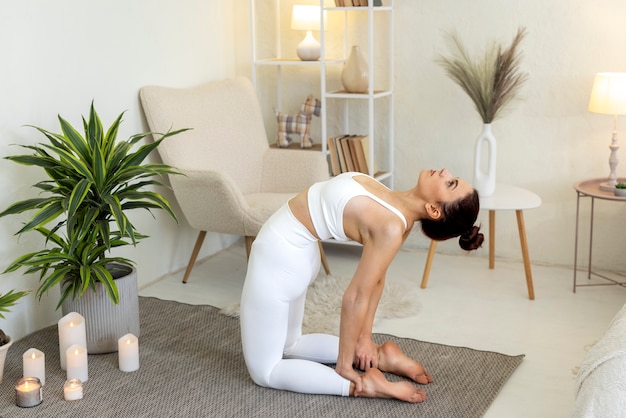
Yoga isn’t just about being flexible; it can also boost your memory and improve your heart and bone health, says Anna Magee.
In the UK, yoga has become incredibly popular, with people spending around £790 million each year on yoga classes and mats. While there are some quirky yoga trends like rage or naked yoga, or even yoga with dogs, the true benefits of yoga are being backed by science.
Researchers from UCLA found that a three-month course of yoga and meditation was more effective than memory exercises at reducing age-related brain decline. Another study showed yoga improved sleep for breast cancer survivors.
Lucy Edge, a former advertising executive, chose yoga over antidepressants when she was struggling with depression. She spent six months in India learning yoga, which left her feeling happier and more content. Lucy has written books on yoga and founded Yoga Meds, which lists clinical trials showing the benefits of yoga for various conditions like arthritis and insomnia.
Here’s how yoga can benefit your health and how you can start:
Improve Your Memory:
If you’ve been focusing on puzzles and Sudoku to keep your mind sharp, consider adding yoga to the mix. In a UCLA study with adults over 55, those who did yoga and meditation had better memory improvements and less depression and anxiety compared to those who only did memory exercises. Kundalini yoga, which includes breathing techniques, meditation, and chanting, was particularly effective.
Boost Heart Health:
Yoga might be just as good for your heart as traditional exercises like brisk walking. A 2014 study published in the European Journal of Preventative Cardiology found that yoga can lower the risk of heart disease. Stress hormone reduction through yoga helps lower blood pressure and heart rate, which reduces the risk of heart disease.
Charlotte Watts, a yoga teacher and nutritional therapist, recommends gentle yoga poses for reducing stress. Restorative yoga, where postures are supported on bolsters and held for up to 12 minutes, is another great option.
Relieve Back Pain:
Sarah Shone, a physiotherapist and yoga teacher, developed yoga classes for back pain that became part of the NHS’s rehabilitation program. An impressive 87% of participants reported less pain. The National Institute for Health and Care Excellence (NICE) includes yoga as a recommended exercise for lower back pain.
Increase Bone Density and Prevent Incontinence:
Yoga can help with bone density and target pelvic floor muscles, which is great for preventing incontinence. It’s adaptable, making it accessible for all fitness levels.
For beginners, it’s best to start with gentle styles like Hatha or Iyengar yoga. Always inform your teacher about any health issues, and for conditions like back pain, consult your doctor about enrolling in subsidized yoga classes.
Choosing the Right Yoga Mat:
Picking the right yoga mat matters. Consider where you’ll keep it, how often you’ll transport it, and whether you need extra cushioning for joint protection. Healthista recommends the Elephant Cork Yoga mat from Valka Yoga, which is eco-friendly, durable, and provides good joint support.
Yoga blocks can also be helpful. They help you get into poses by adding extra length and stability. Cork blocks, though heavier, offer better grip and support.
Types of Yoga Classes:
– Yin or Restorative Yoga: Done with blankets and bolsters for deep relaxation.
– Vinyasa Flow: Energetic and connects movements with breath.
– Iyengar Yoga: Focuses on precise movements and alignment, using props.
– Anusara Yoga: Combines alignment with flowing movements, often to music.
– Yoga Therapy: Targeted yoga for healing specific injuries or illnesses.
Yoga offers numerous benefits from mental health improvements to physical wellness. Whether you’re a beginner or an experienced practitioner, integrating yoga into your routine can enhance your overall health and quality of life.




